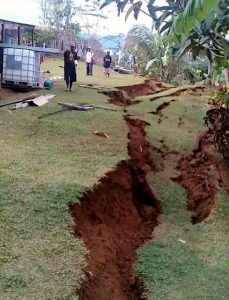
By Tabita Diela and Gayatri Suroyo
JAKARTA (Reuters) – A tsunami of up to two meters hit a small city on the Indonesian island of Sulawesi after a major 7.5 quake struck offshore on Friday, collapsing buildings and washing a vessel ashore, but there was no word on casualties, officials said.
Authorities received information that Palu had been hit, said Dwikorita Karnawati, who heads Indonesia’s meteorology and geophysics agency, BMKG, amid a rapid series of aftershocks.
“The 1.5- to two-meter tsunami has receded,” Karnawati told Reuters. “It ended. The situation is chaotic, people are running on the streets and buildings collapsed. There is a ship washed ashore,” she added.
BMKG had earlier issued a tsunami warning, but lifted it within the hour.
Amateur footage shown by local TV stations, which could not immediately be confirmed by Reuters, showed waters crashing into houses along Palu’s shoreline.
The national search and rescue agency will deploy a large ship and helicopters to aid with the operation, said agency chief Muhammad Syaugi, adding that he had not been able to contact his team in Palu.
Palu, hit by a 6.2 magnitude quake in 2005 which killed one person, is a tourist resort at the end of a narrow bay famous for its beaches and water sports.
In 2004, an earthquake off the northern Indonesian island of Sumatra triggered a tsunami across the Indian Ocean, killing 226,000 people in 13 countries, including more than 120,000 in Indonesia.
Earlier on Friday, the National Disaster Mitigation Agency (BNPB) said it was having difficulty reaching some authorities in Palu and the fishing town of Donggala, closest to the epicenter of the quake 80 km (50 miles) away at a shallow 10 km underground.
Palu airport was closed.
The area was hit by a lighter quake earlier in the day, which destroyed some houses, killing one person and injuring at least 10 in Donggala, authorities said.
Some people took to Twitter saying they could not contact loved ones. “My family in Palu is unreachable,” Twitter user @noyvionella said.
The U.S. Geological Survey put the magnitude of the second quake at a strong 7.5, after first saying it was 7.7.
More than 600,000 people live in Donggala and Palu.
“The (second) quake was felt very strongly, we expect more damage and more victims,” Sutopo Purwo Nugroho, BNPB spokesman said.
Indonesia sits on the Pacific Ring of Fire and is regularly hit by earthquakes.
A series of earthquakes in July and August killed nearly 500 people on the holiday island of Lombok, hundreds of kilometers southwest of Sulawesi.
(Reporting by Jakarta newsroom; Editing by Nick Macfie)

